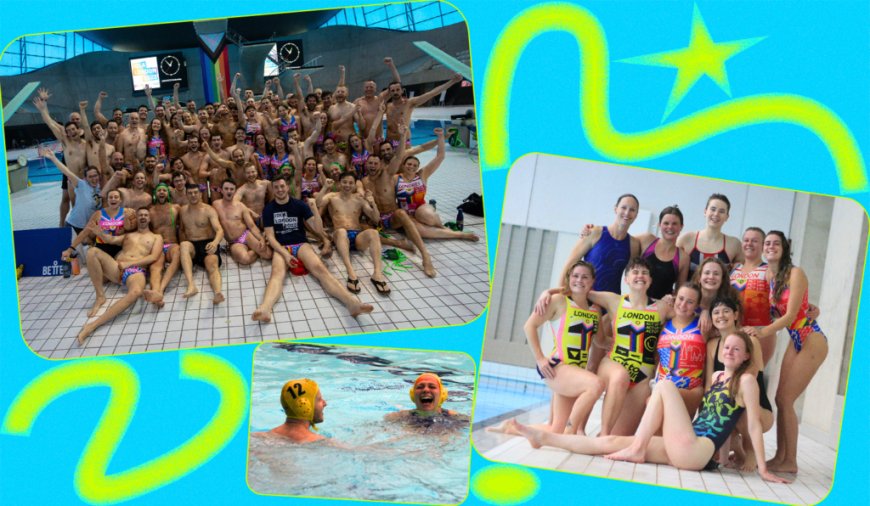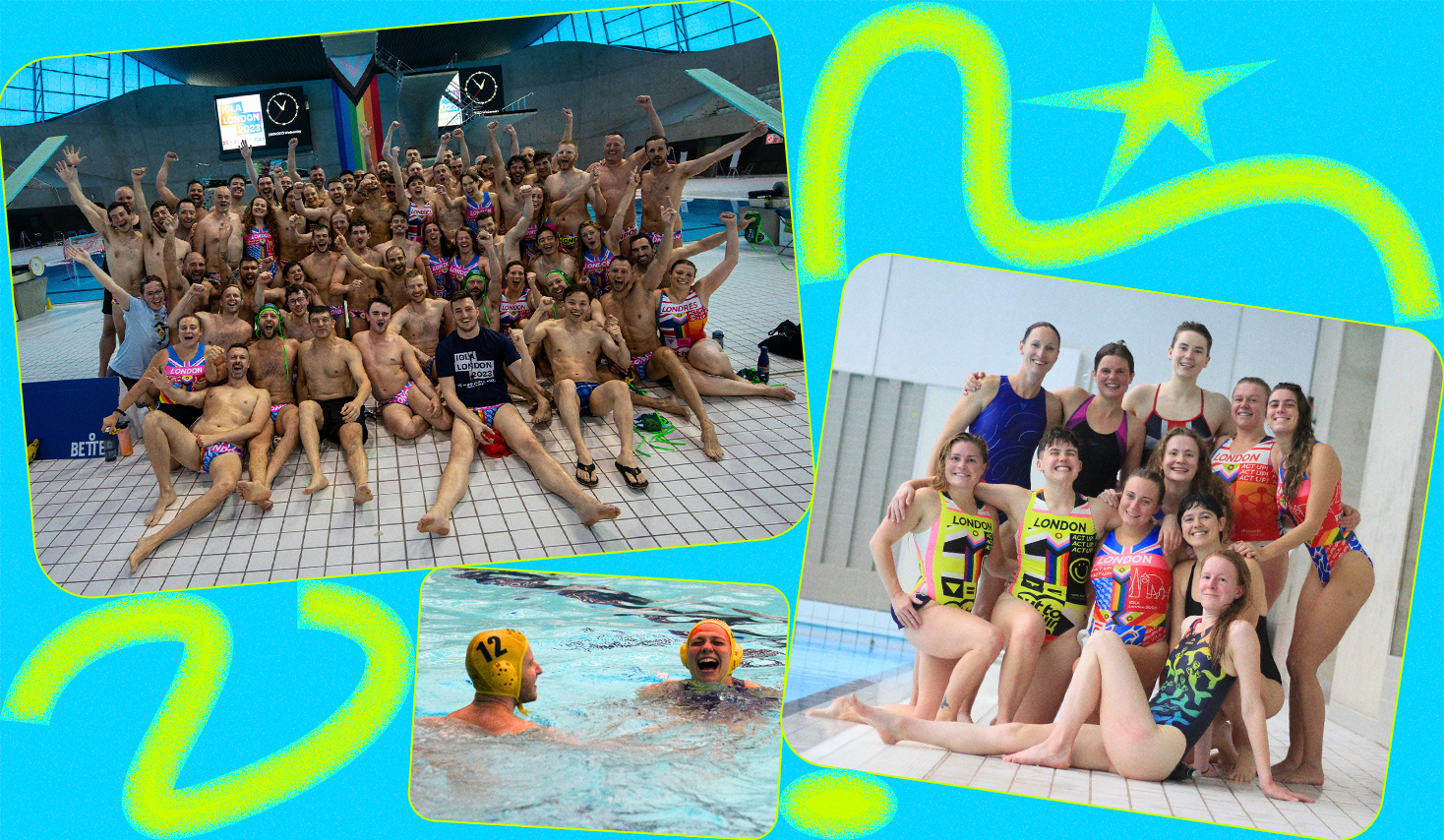You can’t ban trans people from the pool – just ask Out To Swim
The accessible aqua sports club invites swimmers of all gender identities, ages and abilities to find community in the water: here’s how they’re pushing inclusion forward. WORDS JAMIE WINDUST HEADER… The post You can’t ban trans people from the pool – just ask Out To Swim appeared first on GAY TIMES.


The accessible aqua sports club invites swimmers of all gender identities, ages and abilities to find community in the water: here’s how they’re pushing inclusion forward.
WORDS JAMIE WINDUST
HEADER IMAGES SUPPLIED BY OUT TO SWIM, DESIGN BY YOSEF PHELAN

This is State of Play, a new column by GAY TIMES Contributing Editor Jamie Windust. Every month, Jamie will be jumping, running and diving head-first into the world of sport, movement and fitness.
Exploring queer sporting excellence at every level, they’ll also be reporting on the changes that need to be made in order to make the world of sport fully accessible to all within the community.
Despite swimming’s mental and physical benefits, the pool can be a triggering space for trans, non-binary and gender non-conforming folk.
Interview-based research from sources such as the charity Mermaids and the University of Bournemouth has shown that young trans people have negative associations with swimming – seeing the pool as a space of exclusion and intimidation.
A major deterrent to trans and non-binary folks is the degree of body exposure involved in the sport – often due to the form-fitting swimming trunks or suits required for swimming – as well as binary changing rooms.
And it’s not just restricted to research – many of us know the struggle first-hand. No matter where we identify under the LGBTQIA+ umbrella, plenty of us will have memories from our youth of being bullied in pool changing rooms for simply being queer and expressing ourselves in ways that defied societal norms.
Alongside the name-calling and physical violence, there’s the psychological violence of the gendered norms around swimwear, creating painful dysphoric memories that hindered our ability to feel joy in our gender identity as well as confidence in our abilities to learn a new skill.
The transphobic tide in swimming and beyond
These historical experiences often stay with us into adulthood, creating negative connotations around swimming as a sport. However, recent moves at an institutional level are only consolidating – rather than challenging – these associations.
So, time for some context. Traditionally, from 2016, trans inclusion in elite sports was primarily determined through the monitoring of hormone levels. Namely, the International Olympic Committee (IOC) required all female competitors to prove they had testosterone levels below 10 nanomoles/litre (later reduced to 5 nanomoles/litre in 2018) and stipulated that transfeminine athletes undergo hormone therapy for at least a year.
The fixation on hormones came with plenty of negatives – its invasive nature, for one, as well as the fact that athletes such as Caster Semenya and Francine Niyonsaba were found to exceed the required levels and were barred from competition. Perhaps as a result of these drawbacks, the IOC then released new guidance, allowing individual sports associations to set their own rules regarding trans inclusion.
In the case of swimming, and various other sports, this has opened the door to bans which disqualify all transfeminine individuals from competing – arguing that “male development” creates an innate biological advantage. (FYI, this is contrary to the IOC advice, which advocates that sporting bodies make no “presumption of advantage”.)
So, in 2022, the World Aquatics Association (WAA – formerly FINA) effectively banned trans women from participating in women’s swimming categories, disqualifying all trans women and transfeminine people who physically transitioned after the age of 12. For those excluded from the women’s category, they created an “open” competition for trans and non-binary people.
However, much like a dad at a poolside resort in Benidorm after a couple of beers, the new category flopped. At the close of registration for the new category there were a total of zero applicants. Why? Because there aren’t any trans women competing at this level of swimming.
Here in the UK, Swim England seemed to go a step further – excluding anyone “born male” from the women’s category and, following the WAA’s lead by introducing an “open” category for trans and non-binary swimmers.
For trans and non-binary folks, these kinds of measures – and the attendant tabloid fixation on trans athletes – represent a walk back on inclusion and sends a clear message to gender diverse folks of all swimming abilities: you aren’t welcome.
Out To Swim is a life raft amid in queerphobic waters
As ever consistent transphobia continues to pollute the pool, grassroots groups are a beacon of hope in what has become murky waters.
Out To Swim (OTS), founded in 1992, is an aquatics club that invites swimmers of all gender identities, ages and abilities to find community in the water. Whether it be water polo, artistic swimming or just plain old swimming lessons, the group has locations in Bristol, Brighton and London to help queer swimmers rediscover the joy of the pool that may have been lost in their youth.
As Lucy Galoppa – the chair of OTS water polo team London Orca – puts it, the consistency that comes with being part of a group helps her not just physically, but mentally. “It provides a constant which doesn’t budge. It also has so many physical benefits,” Galoppa explains. “In particular, [swimming] helps with my cardio, reflexes, and just overall fitness.”
As Galoppa shares, some members have joined Out To Swim as a result of feeling discouraged or fearful of non-queer water polo clubs. “We have definitely had members join after attempting to join non-queer swimming/waterpolo spaces,” Galoppa explains. “Team sports and waterpolo can be particularly macho spaces making it difficult to feel comfortable and yourself.”
Jasmine*, who is a member of Out To Swim in Bristol, explains that training as part of a queer-focussed swimming group has made them feel more comfortable in their body as a non-binary person. “The training itself has made me feel more comfortable and confident in a pool setting,” they say. “Improving my technique and feeling stronger has made me more comfortable in my body.”
For Jasmine, swimming provides an escape from the often loud world outside. “When I swim I don’t have time to think about how I’m being perceived since I’m focused on the task at hand, and that is quite freeing. That is especially the case with Out to Swim.”
Trans pride, in the pool
Across all locations Out To Swim’s core messages of inclusion is focused on allowing their queer and non-cis members to train in a skill that they love.
In 2022, Out To Swim Bristol teamed up with Trans Pride South West for a “give it a go” session allowing trans and non-binary beginners to safely step into the water, as well as providing them with a sober space to connect after.
But the efforts towards queer inclusion go much deeper, with the group seeking to challenge the pre-existing norms in the swimming world.
Bill Holmes has been a member of OTS for over twenty years and sees the group’s ability to listen and adapt as one of the most important things it can do for trans+ members. “As an LGBTQ+ club, Out to Swim puts an emphasis on outreach to the trans+ community,” Holmes explains. “Our trans+ members are as diverse as the club, some are in the most competitive parts of the club, others are beginners. The important thing is that they are with us and I have found OTS to be willing to listen on how to make the club as inclusive as possible.”
Already, members of OTS are free to wear whatever swimwear they feel most comfortable in at the pool, and coaches are trained to use ‘gender agnostic’ language. Members and coaches alike are encouraged to share their pronouns, no matter what their gender identity is, to create an open space for those who wish to share their chosen pronouns/name.
As a non-binary person, Jasmine explains that this trans-friendly environment allows them to focus on the sport they love. “It’s quite a liberating and freeing experience to participate in my favourite sport with a group of people I know I don’t have to hide myself from,” they say. “In other spaces it can often feel like my identity and how I’m being perceived is constantly on my mind. I can just focus on the sport I love and spend time with friends.”
Swimming as a sober space
With many queer spaces having a focus on alcohol or nightlife, the community of fitness minded swimmers in a body-diverse, non-sexualised space that OTS have created is positively radical.
Tom McCormack, a member of the group since 2017, explains that OTS has created a space to connect with other queer folks in a sober atmosphere. “Out To Swim is a non sexualised space where you can meet other people from your community,” he shares. “A lot of other places you go to, speaking as a gay man, are very sex-focussed or cruisey – gyms, bars, clubs. Everybody at OTS has joined to improve their fitness and to make new friends in an inclusive, welcoming environment.”
Groups like Out To Swim provide community for queer folk wanting to take off the layers of sports-related shame that were placed upon so many of us. But let it be known too that amidst the loudness of hate, there’s power in the solitary act of taking yourself down to your local pool, wearing whatever you feel comfortable in, and enjoying the stillness and serenity that the water can provide.
To find out more about Out To Swim and where your local group is, check out their website or follow them on Instagram.
Explore more of GAY TIMES’ sport coverage here.
The post You can’t ban trans people from the pool – just ask Out To Swim appeared first on GAY TIMES.

 Mark
Mark 





